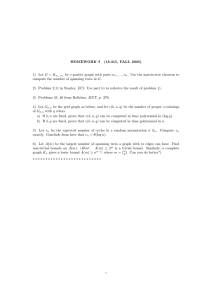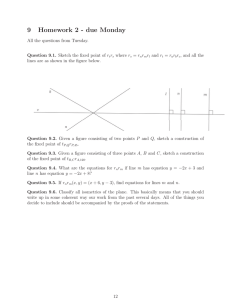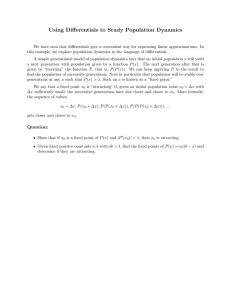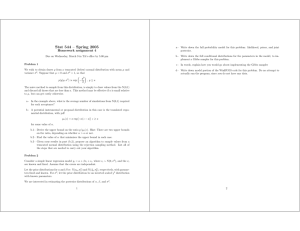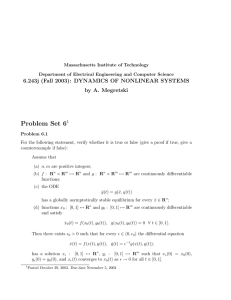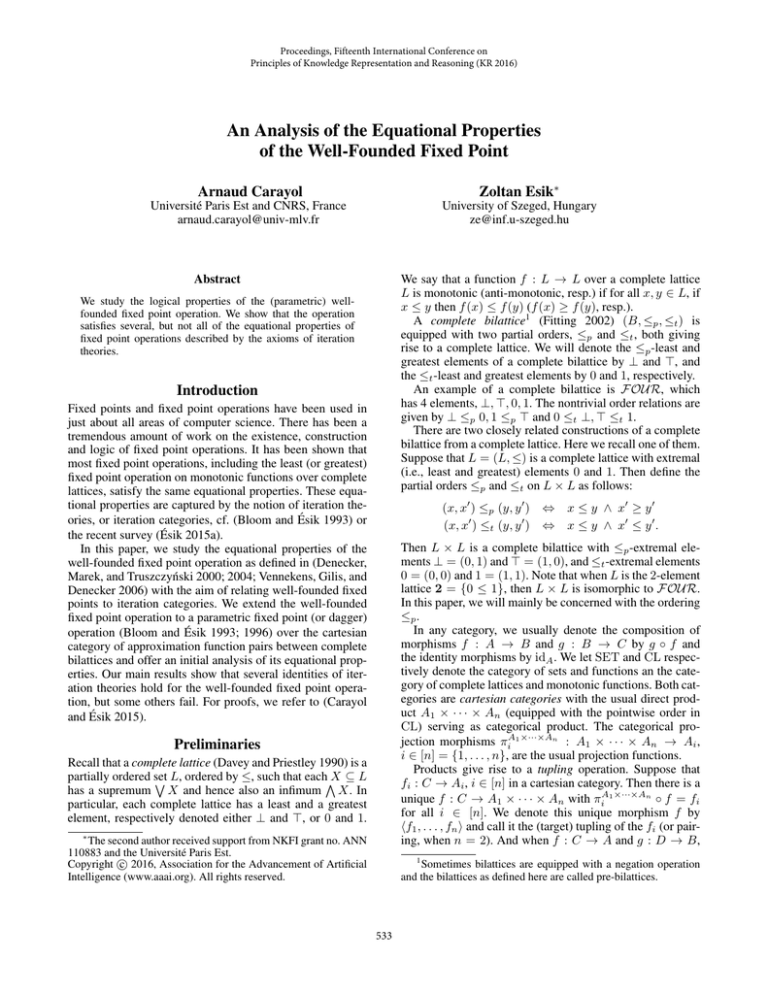
Proceedings, Fifteenth International Conference on
Principles of Knowledge Representation and Reasoning (KR 2016)
An Analysis of the Equational Properties
of the Well-Founded Fixed Point
Arnaud Carayol
Zoltan Esik∗
Université Paris Est and CNRS, France
arnaud.carayol@univ-mlv.fr
University of Szeged, Hungary
ze@inf.u-szeged.hu
We say that a function f : L → L over a complete lattice
L is monotonic (anti-monotonic, resp.) if for all x, y ∈ L, if
x ≤ y then f (x) ≤ f (y) (f (x) ≥ f (y), resp.).
A complete bilattice1 (Fitting 2002) (B, ≤p , ≤t ) is
equipped with two partial orders, ≤p and ≤t , both giving
rise to a complete lattice. We will denote the ≤p -least and
greatest elements of a complete bilattice by ⊥ and , and
the ≤t -least and greatest elements by 0 and 1, respectively.
An example of a complete bilattice is FOUR, which
has 4 elements, ⊥, , 0, 1. The nontrivial order relations are
given by ⊥ ≤p 0, 1 ≤p and 0 ≤t ⊥, ≤t 1.
There are two closely related constructions of a complete
bilattice from a complete lattice. Here we recall one of them.
Suppose that L = (L, ≤) is a complete lattice with extremal
(i.e., least and greatest) elements 0 and 1. Then define the
partial orders ≤p and ≤t on L × L as follows:
Abstract
We study the logical properties of the (parametric) wellfounded fixed point operation. We show that the operation
satisfies several, but not all of the equational properties of
fixed point operations described by the axioms of iteration
theories.
Introduction
Fixed points and fixed point operations have been used in
just about all areas of computer science. There has been a
tremendous amount of work on the existence, construction
and logic of fixed point operations. It has been shown that
most fixed point operations, including the least (or greatest)
fixed point operation on monotonic functions over complete
lattices, satisfy the same equational properties. These equational properties are captured by the notion of iteration theories, or iteration categories, cf. (Bloom and Ésik 1993) or
the recent survey (Ésik 2015a).
In this paper, we study the equational properties of the
well-founded fixed point operation as defined in (Denecker,
Marek, and Truszczyński 2000; 2004; Vennekens, Gilis, and
Denecker 2006) with the aim of relating well-founded fixed
points to iteration categories. We extend the well-founded
fixed point operation to a parametric fixed point (or dagger)
operation (Bloom and Ésik 1993; 1996) over the cartesian
category of approximation function pairs between complete
bilattices and offer an initial analysis of its equational properties. Our main results show that several identities of iteration theories hold for the well-founded fixed point operation, but some others fail. For proofs, we refer to (Carayol
and Ésik 2015).
(x, x ) ≤p (y, y )
(x, x ) ≤t (y, y )
⇔ x ≤ y ∧ x ≥ y ⇔ x ≤ y ∧ x ≤ y .
Then L × L is a complete bilattice with ≤p -extremal elements ⊥ = (0, 1) and = (1, 0), and ≤t -extremal elements
0 = (0, 0) and 1 = (1, 1). Note that when L is the 2-element
lattice 2 = {0 ≤ 1}, then L × L is isomorphic to FOUR.
In this paper, we will mainly be concerned with the ordering
≤p .
In any category, we usually denote the composition of
morphisms f : A → B and g : B → C by g ◦ f and
the identity morphisms by idA . We let SET and CL respectively denote the category of sets and functions an the category of complete lattices and monotonic functions. Both categories are cartesian categories with the usual direct product A1 × · · · × An (equipped with the pointwise order in
CL) serving as categorical product. The categorical projection morphisms πiA1 ×···×An : A1 × · · · × An → Ai ,
i ∈ [n] = {1, . . . , n}, are the usual projection functions.
Products give rise to a tupling operation. Suppose that
fi : C → Ai , i ∈ [n] in a cartesian category. Then there is a
unique f : C → A1 × · · · × An with πiA1 ×···×An ◦ f = fi
for all i ∈ [n]. We denote this unique morphism f by
f1 , . . . , fn and call it the (target) tupling of the fi (or pairing, when n = 2). And when f : C → A and g : D → B,
Preliminaries
Recall that a complete lattice (Davey and Priestley 1990) is a
partially ordered set
L, ordered by ≤, such that eachX ⊆ L
has a supremum X and hence also an infimum X. In
particular, each complete lattice has a least and a greatest
element, respectively denoted either ⊥ and , or 0 and 1.
∗
The second author received support from NKFI grant no. ANN
110883 and the Université Paris Est.
c 2016, Association for the Advancement of Artificial
Copyright Intelligence (www.aaai.org). All rights reserved.
1
Sometimes bilattices are equipped with a negation operation
and the bilattices as defined here are called pre-bilattices.
533
•
f1i , f2i : C → Ai in CL is h = h1 , h2 . We will denote it
•
by f 1 , . . . , f n : C → A1 × · · · × An .
Proposition 1 CL is a cartesian category in which the
product of any objects A1 , . . . , An agrees with their product in CL.
For further use, we note the following. Suppose that ρ :
[m] → [n] and A1 , . . . , An are complete lattices. Then the
•
associated morphism ρA1 ,...,An : A1 × · · · × An → Aρ(1) ×
· · · × Aρ(m) in CL is the function
then we define f × g as the unique morphism h : C × D →
A×B with π1A×B ◦h = f ◦π1C×D and π2A×B ◦h = g◦π2C×D .
When m, n ≥ 0, ρ is a function [m] → [n] and
A1 , . . . , An is a sequence of objects in a cartesian category,
we associate with ρ (and A1 , . . . , An ) the morphism
A1 ×···×An
A1 ×···×An
, . . . , πρ(m)
ρA1 ,...,An = πρ(1)
from A1 × · · · × An to Aρ(1) × · · · × Aρ(m) (Note that in
SET and CL, ρA1 ,...,An maps (x1 , . . . , xn ) ∈ A1 ×· · ·×An
to (xρ(1) , . . . , xρ(m) ) ∈ Aρ(1) × · · · × Aρ(m) .) With a slight
abuse of notation, we usually let ρ denote this morphism
as well. Morphisms of this form are sometimes called base
morphisms. When m = n and ρ is a bijection, then the associated morphism A1 × · · · × An → Aρ(1) × · · · × Aρ(n) is
an isomorphism. Its inverse is the morphism associated with
the inverse ρ−1 of the function ρ. For each object A, the base
morphism associated with the unique function [m] → [1] is
m
the diagonal morphism ΔA
m = idA , . . . , idA : A → A ,
usually denoted just Δm .
A1 × · · · × An × A1 × · · · × An →
Aρ(1) × · · · × Aρ(m) × Aρ(1) × · · · × Aρ(m)
given by
(x1 , . . . , xn , x1 , . . . , xn ) →
(xρ(1) , . . . , xρ(m) , xρ(1) , . . . , xρ(m) ).
Thus, ρA1 ,...,An = ρA1 ,...,An × ρA1 ,...,An , where ρA1 ,...,An
is the morphism associated with ρ and A1 , . . . , An in SET
(or CL). This is in accordance with idA = idA × idA .
•
•
Suppose that f : C → A and g : D → B in CL, so
that f is a function C × C → A × A and g is a function
•
D × D → B × B. Then f × g : C × D → A × B in the
B×A
category CL is the function (idA × π2
, π1B×A × idB ) ◦
D×C
D×C
h ◦ (idC × π2
, π1
× idD ) from C × D × C × D
to A × B × A × B, where h is f × g : C × C × D × D →
A × A × B × B in SET.
The category CL
The objects of CL are complete lattices. Suppose that A, B
are complete lattices. A morphism from A to B in CL, de•
noted f : A → B, is a ≤p -monotonic function f : A × A →
B × B, where A × A and B × B are the complete bilatices determined by A and B. Thus, f = f1 , f2 such that
f1 : A × A → B is monotonic in its first argument and antimonotonic in the second argument, and f2 : A × A → B is
anti-monotonic in its first argument and monotonic in its second argument. (Such functions f are called approximations
in (Vennekens, Gilis, and Denecker 2006).) Composition is
ordinary function composition and for each complete lattice
•
A, the identity morphism idA : A → A is the identity function idA×A = idA × idA = π1A×A , π2A×A : A × A →
A × A.
The category CL has finite products. (Actually it has
all products). Indeed, a terminal object T of CL is any 1element lattice. Suppose that A1 , . . . , An are complete lattices. Then consider the direct product A1 × · · · × An as
an object of CL together with the following morphisms
•
πiA1 ×···×An : A1 × · · · × An → Ai , i ∈ [n]. For each i,
πiA1 ×···×An is the function A1 ×· · ·×An ×A1 ×· · ·×An →
Ai × Ai defined by πiA1 ×···×An (x1 , . . . , xn , x1 , . . . , xn ) =
(xi , xi ), so that in SET, πiA1 ×···×An can be written as
Some subcategories
Motivated by (Denecker, Marek, and Truszczyński 2000;
2004; Vennekens, Gilis, and Denecker 2006), we define several subcategories of CL. Suppose that A, B are complete
lattices. Following (Denecker, Marek, and Truszczyński
2000), we call an ordered pair (x, x ) ∈ A × A consistent
•
if x ≤ x . Moreover, we call f : A → B in CL consistent if it maps consistent pairs to consistent pairs. The
consistent morphisms in CL determine a cartesian subcategory of CL with the same product diagrams. Let CCL
denote this subcategory. We define two subcategories of
CCL. The first one, ACL, is the subcategory determined
•
by those morphisms f = f1 , f2 : A → B in CL such
that f1 (x, x) ≤ f2 (x, x) for all x ∈ A. The second, EACL,
•
is the subcategory determined by those f : A → B with
f1 (x, x) = f2 (x, x). These are again cartesian subcategories
with the same product diagrams.
As noted in (Denecker, Marek, and Truszczyński 2000),
most applications of approximation fixed point theory use
symmetric functions. We introduce the subcategory of CL
having complete lattices as object but only symmetric ≤p •
preserving functions as morphisms. Suppose that f : A →
B in CL, say f = f1 , f2 , We call f symmetric if
f2 (x, x ) = f1 (x , x), i.e., when
A1 ×···×An ×A1 ×···×An
=
πiA1 ×···×An ×A1 ×···×An , πn+i
A1 ×···×An
A1 ×···×An
× πi
.
= πi
It is easy to see that the morphisms πiA1 ×···×An , i ∈ [n],
determine a product diagram in CL. To this end, let f i =
•
f1i , f2i : C → Ai in CL, for all i ∈ [n], so that each
i
f is a ≤p -monotonic function C × C → Ai × Ai . Then
let h = h1 , h2 be the function C × C → A1 × · · · ×
An × A1 × · · · × An , where h1 = f11 , . . . , f1n and h2 =
f21 , . . . , f2n . Thus, h1 and h2 are functions C × C → A1 ×
· · · × An . The tupling of any sequence of morphisms f i =
f2 = f1 ◦ π2A×A , π1A×A : A × A → B.
The symmetric morphisms determine a subcategory of CL,
denoted SCL. In fact, SCL is a subcategory of EACL.
Moreover, it is again a cartesian subcategory with the same
products.
534
•
f : A × B → A.
Fixed points
Suppose that A and B are complete lattices, ordered by ≤,
and let f : A × B → A be a monotonic function. The least
fixed point operation on CL maps f to the monotonic function f † : B → A such that for all y ∈ B, f † (y), sometimes
also denoted μx.f (x, y), is the least solution of the fixed
point equation x = f (x, y). The existence of f † (y) is guaranteed by the Knaster-Tarski fixed point theorem. It is also
known that f † (y) is the least z ∈ A such that f (z, y) ≤ z.
In this section, we recall from (Denecker, Marek, and
Truszczyński 2000) the construction of stable and well•
founded fixed points. Suppose that f = f1 , f2 : A → A in
CL, so that f is a ≤p -monotonic function A × A → A × A.
Then f1 : A × A → A is monotonic in its first argument and
anti-monotonic in its second argument, and f2 : A × A → A
is monotonic in its second argument and anti-monotonic in
its first argument. Define the functions s1 , s2 : A → A by
s1 (x ) = μx.f1 (x, x )
and
(ρ ◦ f ◦ (ρ−1 × idB ))‡
Also, a special case of the pairing identity (6) holds:
Proposition 4 The following identity holds:
f, g ◦ (π2A×B × idC )‡
•
Proposition 5 The weak functorial dagger implication
•
•
holds: for all f : An × B → An and g : A × B → A
in CL: if f ◦ (Δn × idB ) = Δn ◦ g, then f ‡ = Δn ◦ g ‡ .
Since the weak functorial implication holds, so do the
commutative and group identities (Bloom and Ésik 1993;
Ésik 1999b).
Some identities that fail
Proposition 6 The composition identity
(f ◦ g, π2A×C )‡
•
f ◦ (g ◦ f, π2B×C )‡ , idC ,(5)
•
Proposition 7 The squaring identity (f ◦ f )‡ = f ‡ fails,
•
where f : A → A.
Since the fixed point, parameter and permutation identities hold but the composition identity fails, the pairing identity (6) also must fail, see (Bloom and Ésik 1993).
Iteration categories capture the equational properties of several fixed point operations including the least fixed point
operation over CL. Axiomatizations of iteration categories
can be conveniently divided into two parts, axioms for Conway categories and the commutative (Bloom and Ésik 1993)
or group identities (Ésik 1999b), or the generalized power
identities of (Ésik 1999a). Known axiomatizations of Conway categories include the group consisting of the parameter
(1), composition (5) and double dagger (7) identities, and
the group consisting of the fixed point (2), parameter (1),
pairing (6) and permutation (3) identities. In this section we
establish several of the above mentioned identities for the
parametrized well-founded fixed point operation over CL.
In the next section we will show that several others fail.
Proposition 3 The following parameter (1), fixed point (2)
and permutation (3) identities hold:
Proposition 8 The pairing identity
f, g‡
= f ‡ ◦ h‡ , idC , h‡,
(6)
•
where h = g ◦f ‡ , idB×C fails, where f : A×B ×C → A
•
and g : A × B × C → B.
Proposition 9 The double dagger identity
f ‡‡
=
(f ◦ (idA , idA × idB ))‡ ,
(7)
•
f : A × A × B → A, fails in CL, even in the particular
case when B = T (terminal object).
Some applications
The established identities can be seen as abstract versions
of transformations over logic programs that preserve the
well-founded semantics (in the bilattice setting). For one
example, consider the simple propositional logic program
p : − q, ∼ r; q : − r, ∼ p; r : − p, ∼ q. Identifying p, q, r,
we obtain p : − p, ∼ p. By the weak functorial implication,
(1)
•
for all f : A × B → A and g : C → B.
f ‡,
=
f : B × C → A, g : A × C → B, fails in CL, even in
the following simple case: f ◦ (f ◦ f )‡ = (f ◦ f )‡ , where
•
f : A → A.
Some valid identities
f ◦ f ‡ , idB =
•
The identity (4) has already been established in Theorem
3.11 of (Vennekens, Gilis, and Denecker 2006), see also the
Splitting Set Theorem of (Lifschitz and Turner 1994).
•
•
= f ‡ ◦ g ‡ , idC , g ‡, (4)
where f : A × B × C → A and g : B × C → B.
Proposition 2 Suppose that f : A × B → A is in CL. Then
•
f ‡ : B → A is also in CL. However, neither of the subcategories CCL, ACL, EACL and SCL is closed under
‡
.
f ‡ ◦ g,
(3)
•
s2 (x) = μx .f2 (x, x ),
=
ρ ◦ f ‡,
for all f : A1 × · · · × An × B → A1 × · · · × An and
permutation ρ : [n] → [n].
and let S(f ) : A×A → A×A be the function S(f )(x, x ) =
(s1 (x ), s2 (x)). Since s1 and s2 are anti-monotonic, S(f ) is
•
a morphism A → A in CL. We call S(f ) the stable function
for f . It is known that every fixed point of S(f ) is a fixed
point of f , called a stable fixed point of f . Since S(f ) is ≤p monotonic, there is a ≤p -least stable fixed point f ‡ , called
the well-founded fixed point of f .
The above construction can slightly be extended. When
•
f : A × B → A is in CL and (y, y ) ∈ B × B, then let
•
g : A → A be given by g(x, x ) = f (x, y, x , y ). Then we
define f ‡ (y, y ) = g ‡ .
(f ◦ (idA × g))‡
=
(2)
535
References
the two programs are equivalent in the sense that each component of the well-founded semantics of the first program
agrees with the well-founded semantics of the second.
By formulating transformations as identities, one can use
standard (many-sorted) equational logic to derive other identities that in turn give rise to new transformations. For example, the following identity is an equational consequence of
those established in the paper:
Bloom, S. L., and Ésik, Z. 1993. Iteration Theories - The
Equational Logic of Iterative Processes. EATCS Monographs on Theoretical Computer Science. Springer.
Bloom, S. L., and Ésik, Z. 1996. Fixed-point operations on
ccc’s. part I. Theor. Comput. Sci. 155(1):1–38.
Carayol, A., and Ésik, Z. 2015. An analysis of the equational properties of the well-founded fixed point. Report,
arXiv:1511.09423.
Davey, B. A., and Priestley, H. A. 1990. Introduction to
lattices and order. Cambridge: Cambridge University Press.
Denecker, M.; Marek, V. M.; and Truszczyński, M. 2000.
Approximations, stable operators, well-founded fixpoints
and applications in nonmonotonic reasoning. In LogicBased Artificial Intelligence. Springer. 127–144.
Denecker, M.; Marek, V. W.; and Truszczyński, M. 2004.
Ultimate approximation and its application in nonmonotonic
knowledge representation systems. Inf. Comput. 192(1):84–
121.
Ésik, Z. 1999a. Axiomatizing iteration categories. Acta
Cybern. 14(1):65–82.
Ésik, Z. 1999b. Group axioms for iteration. Inf. Comput.
148(2):131–180.
Ésik, Z. 2015a. Equational properties of fixed point operations in cartesian categories: An overview. In MFCS 2015,
Proceedings, Part I, volume 9234 of LNCS, 18–37. Springer.
Ésik, Z. 2015b. Equational properties of stratified least fixed
points (extended abstract). In WoLLIC 2015, Bloomington,
IN, USA, July 20-23, 2015, Proceedings, volume 9160 of
LNCS, 174–188. Springer.
Ferraris, P.; Lee, J.; Lifschitz, V.; and Palla, R. 2009. Symmetric splitting in the general theory of stable models. In
IJCAI 2009, Proceedings, 797–803.
Fitting, M. 2002. Fixpoint semantics for logic programming
a survey. Theor. Comput. Sci. 278(1-2):25–51.
Janhunen, T.; Oikarinen, E.; Tompits, H.; and Woltran, S.
2009. Modularity aspects of disjunctive stable models. J.
Artif. Intell. Res. (JAIR) 35:813–857.
Lifschitz, V., and Turner, H. 1994. Splitting a logic program. In Logic Programming 1994, Proceedings, 23–37.
MIT Press.
Rondogiannis, P., and Wadge, W. W. 2005. Minimum model
semantics for logic programs with negation-as-failure. ACM
Trans. Comput. Log. 6(2):441–467.
Seki, H. 1993. Unfold/fold transformation of general logic
programs for the well-founded semantics. J. Log. Program.
16(1):5–23.
Tamaki, H., and Sato, T. 1984. Unfold/fold transformation
of logic programs. In Second International Logic Programming Conference, Proceedings, 127–138.
Vennekens, J.; Gilis, D.; and Denecker, M. 2006. Splitting
an operator: Algebraic modularity results for logics with fixpoint semantics. ACM Trans. Comput. Log. 7(4):765–797.
A×B ‡
B×C
A×B×C ‡
= f ◦ (idA × g, πC
), g ◦ πB×C
f, g ◦ πB
•
•
where f : A × B × C → A and g : B × C → B.
This identity is an abstract version of the fold/unfold
transformation (Tamaki and Sato 1984; Seki 1993). For example, it yields that the following propositional logic programs p :− q, r; r :− s, t and p :− q, s, t; r :− s, t are equivalent for the well-founded semantics. On the other hand, the
following identity, which is a generalization of the above
A×B
, g, g‡ =
folding/unfolding identity, fails: f ◦ πA
•
•
‡
f, g , where f : A × B → A and g : A × B → B.
And this again follows by standard equational reasoning using our positive and negative results.
Conclusion
We extended the well-founded fixed point operation of (Denecker, Marek, and Truszczyński 2000; Vennekens, Gilis,
and Denecker 2006) to a parametric operation and studied its
equational properties. We found that several of the identities
of iteration theories hold for the parametric well-founded
fixed point operation, but some others fail. By showing that
some identities of iteration theories do not hold, we tried
to have a better understanding why logic programs with the
well-founded semantics cannot be manipulated using standard fixed point methods. And by showing that some other
identities hold, we tried to understand to what extent the
standard techniques can be used for manipulating logic programs. Two interesting questions arise for further investigation. The first concerns the algorithmic description of the
valid identities of the well-founded fixed point operation.
The second concerns the axiomatic description of the valid
identities. These questions are also relevant in connection
with modular logic programing, cf. (Ferraris et al. 2009;
Janhunen et al. 2009; Lifschitz and Turner 1994).
An alternative semantics of logic programs with negation
based on an infinite domain of truth values was proposed
in (Rondogiannis and Wadge 2005). The infinite valued approach has been further developed in the abstract setting
of ‘stratified complete lattices’. It has been proved in (Ésik
2015b) that the stratified least fixed point operation arising
in this approach does satisfy all identities of iteration theories. So in this regards, the infinite valued semantics behaves
just as the Kripke-Kleene semantics (Fitting 2002).
Acknowledgments
The authors would like to thank Panos Rondogiannis for
pointing out some of the references and the refrees for suggesting improvements. The second author would like to
thank the hospitality of the Institute of Informatics Gaspard
Monge of Universté Paris Est.
536


